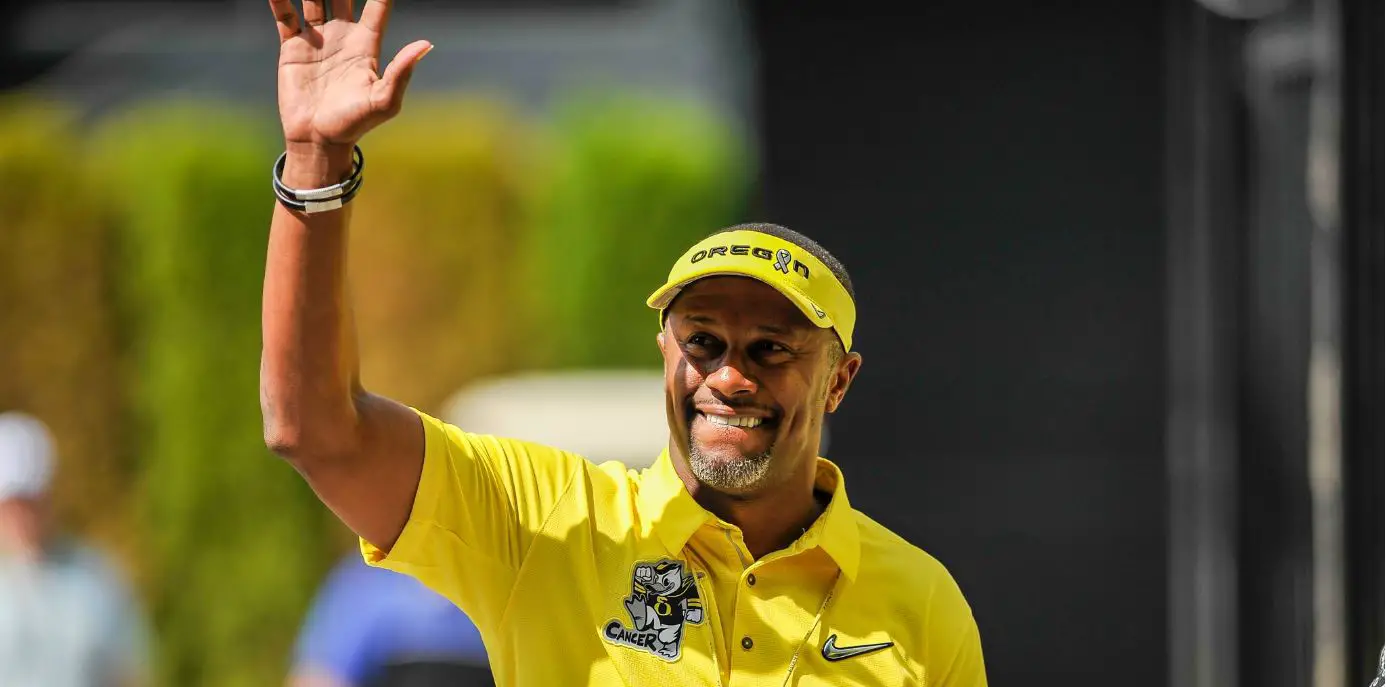Oregon fans are thrilled with Willie Taggart’s 3-0 non-conference debut. In the first half of each game, the Ducks have scored 42 points, and have looked like they could run the table. But their second-half offense has looked sluggish and uninspired. Where is the juice in the second half?
The inferior quality of Oregon’s non-conference schedule amplifies this concern. Southern Utah and talent-starved Wyoming reveal no more than UC Davis and Virginia did last year, while Nebraska just lost to Northern Illinois in embarrassing fashion.
Here are some reasons that problems may surface against better competition.
1. Defensive Youth
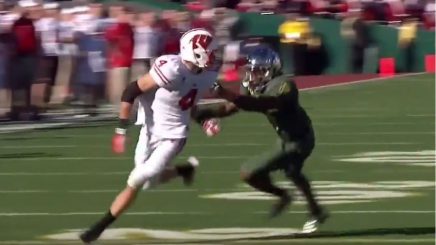
Freshman Ifo about to get exposed in the 2012 Rose Bowl.
True freshman defensive starters Thomas Graham Jr., Nick Pickett, Austin Faoliu and Jordon Scott have looked impressive and signal a bright future. But young players, no matter how talented, will eventually show their youth.
Ifo Ekpre-Olomu and Terrance Mitchell anchored the secondary for years. But in the 2011-2012 season, both showed their youth in critical moments.
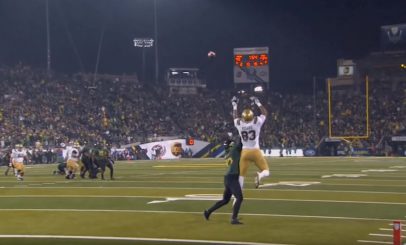
Redshirt Freshman Terrance Mitchell getting posterized in the 2011 Pac-12 Championship Game.
College players are bigger, faster and stronger, which requires adjustment and growth. Oregon’s young starters have showed flashes of genuine brilliance, but have also showed inexperience (e.g. Graham’s pass interference penalties). As conference play begins, better quarterbacks and receivers may expose the youth in the secondary. And more dominant offensive lines may overwhelm the young nose tackles.
2. Power Running with Small Bodies
As Charles wrote before the season began, Oregon’s offensive line lacks the size for a power running scheme. The Ducks struggled to run the ball between the tackles against Nebraska (Mick Stoltenberg was a constant headache), and early in the game against Wyoming. Even with five returning starters, Oregon has failed to consistently move the line of scrimmage against talented defensive linemen.
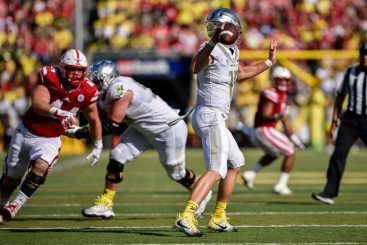
Stoltenberg applying pressure.
Can the Ducks establish the inside run game against perennially hard-nosed Stanford or reloaded Washington? Time will tell, but Taggart is already recruiting bigger offensive linemen. Three of the 2018 commits weigh between 325 and 355 pounds.
This season, if the Ducks have trouble running the ball inside with their undersized linemen, Taggart won’t be able to implement all of his Spread-Power scheme. That will limit the offense.
3. Herbert’s Deep Ball
There’s no nice way to say this: Justin Herbert struggled to complete deep passes in 2016, managing only 19 completions of over 25 yards. When compared to Vernon Adams Jr.‘s 2015 total of 37, Herbert’s vertical passing is a letdown. And it isn’t just the stats; the 2016 tape shows that while Herbert has the arm strength to make long throws, he doesn’t have the accuracy to stretch the field.

Vernon Adams Jr. uncorking another bomb.
This might not be cause for alarm — yet. Adams was Oregon’s best deep-ball passer since Joey Harrington, at least (Adams averaged nearly 3 more yards per attempt than Harrington). And, like Herbert, Marcus Mariota also completed only 19 passes over 25 yards in his first year. Already in 2017, Herbert has completed 11 passes over 25 yards, and his deep-ball accuracy looks much improved.
But that improvement is against the aforementioned Southern Utah, Nebraska, and Wyoming. It remains to be seen whether Herbert can stretch the field against Pac-12 competition. If he can’t, Oregon’s young receivers will have to make plays after the catch.
4. A Deep Pac-12
The Pac-12 is the deepest conference in the country. Seven Pac-12 teams have started the season 3-0, while no other Power-5 conference has more than five. The Pac-12 North is going to be a slugfest with four 3-0 teams, plus Stanford likely to rebound after two tough losses. The Ducks avoid Colorado and USC during the regular season, but must run the gauntlet of Pac-12 North teams plus undefeated and revenge-minded Utah, who will test Oregon’s young secondary with Darren Carrington averaging 136 receiving yards per game.
Oregon’s defense has improved, but even a below-average Pac-12 offense will be better than any the Ducks have faced this year. Wyoming’s Josh Allen missed wide-open throws that Luke Falk and Jake Browning won’t.
In the next two weeks, Oregon could beat Arizona State and California and be 5-0. But the Ducks could lose the five after that, against Washington State, Stanford, UCLA, Utah, and Washington (though, this year, Cal looks like a harder test than Stanford or UCLA).
5. Willie Taggart
In the last two games, Oregon has managed only one second-half touchdown. Failing to score against Nebraska in the second half almost cost Oregon the game.
When asked about this, Taggart has been evasive, citing a need for better “execution.” True or not, that response is troubling. If it’s true that Oregon’s ability to execute on offense unexplainably implodes in the second half, Taggart needs to understand why and make the necessary adjustments. On the other hand, it’s possible something else is going on.
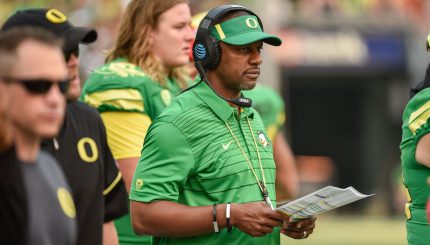
Coach Taggart: Play-Caller Extraordinaire.
Opposing coaches might be out-coaching Oregon. Taggart says his offense is lethal in its simplicity. That’s great, as long as it’s not so simple that opponents can see it in the first half, and stop Oregon with halftime adjustments.
Another possibility is that Taggart has been burning clock in the second half. After the Nebraska game, he said the Ducks were running the same plays as in the first half, but were failing to execute. However, they only attempted eight passes in the second half, against 25 in the first. Burning clock, in other words. There is a time to slow down the offense, but playing not to lose typically backfires.
Maybe Taggart saw the last two games as an opportunity to try out a “ground and pound” set. That’s fine, but if so he came mighty close to losing to Nebraska because of it. Oregon fans have bad memories of stubborn play calling; Chip Kelly repeatedly tried to run between the tackles in the National Championship against Auburn, and Nick Fairley was having none of it. Hopefully Taggart understands when to shift strategies and let his superstar-in-the-making quarterback throw downfield.
So far, Taggart has succeeded where it counts: the win-loss column. But if the Ducks start to falter as they enter Pac-12 play, look to these weak points as the cause. Some will be harder to change than others; there’s no guarantee that bigger-bodied offensive linemen will be as skilled as the current set. And the competitiveness of the Pac-12 isn’t going anywhere soon. But some factors are well within the control of the players and coaches. In each game, young players get more experience. Herbert may already be developing a vertical passing attack. And, Taggart can stop calling conservative second halves, if that’s an issue.
Let’s hope the Ducks make adjustments before these issues start showing up as losses.
Cody Lonning
Oakland, Calif.
Top photo credit: Kevin Cline
Cody inherited all his sports allegiances from his grandfather, a long-time Eugene resident. Even though Cody graduated from law school at Berkeley, he remains a staunch Oregon fan. When he isn’t watching the Ducks, Cody is hiking, engaged in various home-improvement projects, or writing about politics. Cody grew up farming hay and wheat in Eastern Washington. Now, he practices law.

